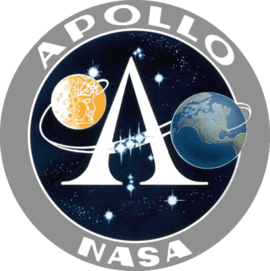Apollo 9
 David Scott performs an EVA from Command Module Gumdrop, seen from docked Lunar Module Spider | |||||
| Mission type | Lunar Module test flight | ||||
|---|---|---|---|---|---|
| Operator | NASA[1] | ||||
| COSPAR ID |
| ||||
| SATCAT № |
| ||||
| Mission duration | 10 days, 1 hours, 54 seconds | ||||
| Spacecraft properties | |||||
| Spacecraft |
| ||||
| Manufacturer |
| ||||
| Launch mass | 95,231 pounds (43,196 kg) | ||||
| Landing mass | 11,094 pounds (5,032 kg) | ||||
| Crew | |||||
| Crew size | 3 | ||||
| Members | |||||
| Callsign |
| ||||
| EVAs | 1 | ||||
| EVA duration | 77 minutes | ||||
| Start of mission | |||||
| Launch date | March 3, 1969, 16:00:00 UTC | ||||
| Rocket | Saturn V SA-504 | ||||
| Launch site | Kennedy LC-39A | ||||
| End of mission | |||||
| Recovered by | USS Guadalcanal | ||||
| Decay date | October 23, 1981 (LM) | ||||
| Landing date | March 13, 1969, 17:00:54 UTC | ||||
| Landing site |
North Atlantic Ocean 23°15′N 67°56′W / 23.250°N 67.933°W | ||||
| Orbital parameters | |||||
| Reference system | Geocentric | ||||
| Regime | Low Earth orbit | ||||
| Perigee | 204 kilometers (127 mi) | ||||
| Apogee | 497 kilometers (309 mi) | ||||
| Inclination | 33.8 degrees | ||||
| Period | 91.55 minutes | ||||
| Epoch | March 5, 1969[2] | ||||
| Docking with LM | |||||
| Docking date | March 3, 1969, 19:01:59 UTC | ||||
| Undocking date | March 7, 1969, 12:39:06 UTC | ||||
| Docking with LM Ascent Stage | |||||
| Docking date | March 7, 1969, 19:02:26 UTC | ||||
| Undocking date | March 7, 1969, 21:22:45 UTC | ||||
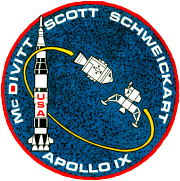  Left to right: McDivitt, Scott, Schweickart
| |||||
Apollo 9 was the third manned mission in the United States Apollo space program and the first flight of the Command/Service Module (CSM) with the Lunar Module (LM, pronounced "lem"). Its three-person crew, consisting of Commander James McDivitt, Command Module Pilot David Scott, and Lunar Module Pilot Rusty Schweickart, spent ten days in low Earth orbit testing several aspects critical to landing on the Moon, including the LM engines, backpack life support systems, navigation systems, and docking maneuvers. The mission was the second manned launch of a Saturn V rocket.
After launching on March 3, 1969, the crewmen performed the first manned flight of a LM, the first docking and extraction of a LM, two spacewalks (EVA), and the second docking of two manned spacecraft—two months after the Soviets performed a spacewalk crew transfer between Soyuz 4 and Soyuz 5. The mission proved the LM worthy of manned spaceflight. Further tests on the Apollo 10 mission would prepare the LM for its ultimate goal, landing on the Moon. They returned to Earth on March 13, 1969.
Crew
| Position[3] | Astronaut | |
|---|---|---|
| Commander | James A. McDivitt Second spaceflight | |
| Command Module Pilot | David R. Scott Second spaceflight | |
| Lunar Module Pilot | Russell L. Schweickart Only spaceflight | |
Backup crew
| Position | Astronaut | |
|---|---|---|
| Commander | Charles Conrad, Jr. | |
| Command Module Pilot | Richard F. Gordon, Jr. | |
| Lunar Module Pilot | Clifton C. Williams, Jr. | |
| This crew became the prime crew on Apollo 12. * | ||
* Williams was killed in October 1967 when the T-38 he was flying crashed near Tallahassee, and was replaced with Alan L. Bean.
Support crew
Flight directors
- Gene Kranz, White team
- Gerry Griffin, Gold team
- Pete Frank, Orange team
Mission parameters
- Mass: CSM 26,801 kg; LM 14,575 kg
- Perigee: 189.5 km
- Apogee: 192.4 km
- Inclination: 32.57°
- Period: 88.64 min
LM - CSM docking
- Undocked: March 7, 1969 - 12:39:36 UTC
- Re-docked:March 7, 1969 - 19:02:26 UTC
EVA
- Schweickart - EVA - LM forward hatch
- Start: March 6, 1969, 16:45:00 UTC
- End: March 6, 1969, 17:52:00 UTC
- Duration: 1 hour, 07 minutes
- Scott - Standup EVA - CM side hatch
- Start: March 6, 1969, 17:01:00 UTC
- End: March 6, 1969, 18:02:00 UTC
- Duration: 1 hour, 01 minute
Mission background

In April 1966, McDivitt, Scott, and Schweickart were selected by Deke Slayton as the second Apollo crew, as backup to Gus Grissom, Ed White, and Roger Chaffee for the first manned Earth orbital test flight of the block I Command/Service Module,[4] designated AS-204 expected to fly in late 1966. This was to be followed by a second block I flight, AS-205, to be crewed by Wally Schirra, Donn Eisele, and Walter Cunningham. The third manned mission, designated AS-207/208, was planned to fly the block II Command Module and the Lunar Module in Earth orbit, launched on separate Saturn IBs, with a crew to be named.
However, delays in the block I CSM development pushed AS-204 into 1967. By December 1966, the original AS-205 mission was cancelled, Schirra's crew was named as Grissom's backup, and McDivitt's crew was promoted to prime crew for the LM test mission,[5] re-designated AS-205/208. On January 26, 1967, they were training for this flight, expected to occur in late 1967, in the first block II Command Module 101 at the North American plant in Downey, California.[6] The next day, Grissom's crew were conducting a launch-pad test for their planned February 21 mission, which they named Apollo 1, when a fire broke out in the cabin, killing all three men and putting an 18-month hold on the manned program while the block II Command Module (CM) and A7L pressure suit were redesigned for safety.
As it turned out, a 1967 launch of AS-205/208 would have been impossible even absent the Apollo 1 accident, as problems with the LM delayed its first unmanned test flight until January 1968. NASA was able to use the 18-month hiatus to catch up with development and unmanned testing of the LM and the Saturn V launch vehicle.[7]
By October 1967, planning for manned flights resumed, with Apollo 7 being the first Earth orbit CSM flight (now known as the C mission) in October 1968 given to Schirra's crew, and McDivitt's mission (now known as the D Mission) following as Apollo 8 in December 1968, using a single Saturn V instead of the two Saturn IBs. This would be followed by a higher Earth orbit flight (E Mission), to be crewed by Frank Borman, Michael Collins, and William Anders in early 1969.
However, LM problems again prevented it from being ready for the D mission by December, so NASA officials created another mission for Apollo 8 using the Saturn V to launch only the CSM on the first manned flight to orbit the Moon, and the E mission was cancelled as unnecessary. Slayton asked McDivitt and Borman which mission they preferred to fly; McDivitt wanted to fly the LM, while Borman volunteered for the pioneering lunar flight. Therefore, Slayton swapped the crews, and McDivitt's crew flew Apollo 9.
The crew swap also affected who would be the first crew to land on the Moon; when the crews for Apollo 8 and 9 were swapped, their backup crews were also swapped. Since the rule of thumb was for backup crews to fly as prime crew three missions later, this put Neil Armstrong's crew (Borman's backup) in position for the first landing mission Apollo 11 instead of Pete Conrad's crew, who made the second landing on Apollo 12.
Mission highlights

Apollo 9 was the first space test of the complete Apollo spacecraft, including the third critical piece of Apollo hardware besides the Command/Service Module and the Saturn V launch vehicle—the Lunar Module. It was also the first space docking of two vehicles with an internal crew transfer between them. For ten days, the astronauts put both Apollo spacecraft through their paces in Earth orbit, including an undocking and redocking of the lunar lander with the command vehicle, just as the landing mission crew would perform in lunar orbit. Apollo 9 gave proof that the Apollo spacecraft were up to this critical task, on which the lives of lunar landing crews would depend.
For this and all subsequent Apollo flights, the crews were allowed to name their own spacecraft (the last spacecraft to have been named was Gemini 3). The gangly LM was named Spider, and the CSM was labeled Gumdrop because of the Command Module's shape, and also the blue wrapping in which the craft arrived at Kennedy Space Center. These names were required as radio call signs when the vehicles flew independently.
Schweickart and Scott performed an EVA—Schweickart checked out the new Apollo spacesuit, the first to have its own life support system rather than being dependent on an umbilical connection to the spacecraft, while Scott filmed him from the Command Module hatch. Schweickart was due to carry out a more extensive set of activities to test the suit, and demonstrate that it was possible for astronauts to perform an EVA from the Lunar Module to the Command Module in an emergency, but as he had been suffering from space sickness the extra tests were scratched.
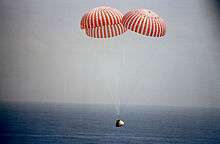
McDivitt and Schweickart later test-flew the LM, and practiced separation and docking maneuvers in Earth orbit. They flew the LM up to 111 miles (179 km) from Gumdrop, using the engine on the descent stage to propel them originally, before jettisoning it and using the ascent stage to return. This test flight represented the first flight of a manned spacecraft that was not equipped to reenter the Earth's atmosphere.
The splashdown point was 23°15′N, 67°56′W, 160 nautical miles (290 km) east of the Bahamas and within sight of the recovery ship USS Guadalcanal. Apollo 9 was the last spacecraft to splash down in the Atlantic Ocean.
The Command Module was displayed at the Michigan Space and Science Center, Jackson, Michigan, until April 2004 when the center closed. In May 2004, it was moved to the San Diego Aerospace Museum (now named the San Diego Air & Space Museum). The LM ascent stage orbit decayed on October 23, 1981, the LM descent stage (1969-018D) orbit decayed March 22, 1969. The S-IVB stage J-2 engine was restarted after Lunar Module extraction and propelled the stage into solar orbit by burning to depletion.
The Saturn IVB third stage became a derelict object where it would continue to orbit the Sun for many years. As of November 2014, it remains in orbit.[8]
Mission insignia
.jpg)
The circular patch shows a drawing of a Saturn V rocket with the letters USA on it. To its right, an Apollo CSM is shown next to an LM, with the CSM's nose pointed at the "front door" of the LM rather than at its top docking port. The CSM is trailing rocket fire in a circle. The crew's names are along the top edge of the circle, with APOLLO IX at the bottom. The "D" in McDivitt's name is filled with red to mark that this was the "D mission" in the alphabetic sequence of Apollo missions. The patch was designed by Allen Stevens of Rockwell International.[9]
Summary of maneuvers
| T + Time | Event | Burn Time | Delta-Velocity | Orbit |
|---|---|---|---|---|
| T + 00:00:00 | Lift-off | |||
| T + 00:02:14.34 | S-IC center engine cut-off | 141 s | ||
| T + 00:02:42.76 | S-IC engine cut-off | 169 s | ||
| T + 00:02:45.16 | S-II ignition | |||
| T + 00:03:13.5 | S-II skirt separation | |||
| T + 00:03:18.3 | LES jettison | |||
| T + 00:08:56.22 | S-II cut-off | |||
| T + 00:08:57 | S-II cutoff + separation, S-IVB ignition | |||
| T + 00:11:04.66 | S-IVB cutoff + orbital insertion | 127.4 s | 191.3 × 189.5 km | |
| T + 02:41:16 | CSM/S-IVB separation | |||
| T + 03:01:59.3 | CSM/LM docking | |||
| T + 04:08:09 | Spacecraft/S-IVB separation | |||
| T + 05:59:01.07 | First Service Propulsion System (SPS) test | 5.1 s | +10.4 m/s | 234.1 × 200.7 km |
| T + 22:13:04.07 | Second SPS test | 110 s | +259.2 m/s | 351.5 × 199.5 km |
| T + 25:17:39.27 | Third SPS test | 281.6 s | +782.6 m/s | 503.4 × 202.6 km |
| T + 28:24:41.37 | Fourth SPS test | 28.2 s | -91.45 m/s | 502.8 × 202.4 km |
| T + 49:41:34.46 | Docked DPS test | 369.7 s | -530.1 m/s | 499.3 × 202.2 km |
| T + 54:26:12.27 | Fifth SPS test | 43.3 s | -175.6 m/s | 239.3 × 229.3 km |
| T + 92:39:36 | CSM/LM undocking | |||
| T + 93:02:54 | CSM separation maneuver | 10.9 s | -1.5 m/s | |
| T + 93:47:35.4 | LM Descent Propulsion System (DPS) phasing maneuver | 18.6 s | +27.6 m/s | 253.5 × 207 km |
| T + 95:39:08.6 | LM DPS insertion maneuver | 22.2 s | +13.1 m/s | 257.2 × 248.2 km |
| T + 96:16:06.54 | LM concentric sequence initiation maneuver/Descent stage jettison | 30.3 s | -12.2 m/s | 255.2 × 208.9 km |
| T + 96:58:15 | LM Ascent Propulsion System (APS) constant delta height maneuver | 2.9 s | -12.6 m/s | 215.6 × 207.2 km |
| T + 97:57:59 | LM terminal phase finalization maneuver | 34.7 s | +6.8 m/s | 232.8 × 208.5 km |
| T + 99:02:26 | CSM/LM docking | |||
| T + 101:22:45 | LM ascent stage jettison | |||
| T + 101:32:44 | Post-jettison CSM separation maneuver | 7.2 s | +0.9 m/s | 235.7 × 224.6 km |
| T + 101:53:15.4 | LM APS burn to depletion | 350 s | +1,643.2 m/s | 6,934.4 × 230.6 km |
| T + 123:25:06.97 | Sixth SPS test | 1.29 s | -11.5 m/s | 222.6 × 195.2 km |
| T + 169:39:00.36 | Seventh SPS test | 25 s | +199.6 m/s | 463.4 × 181.1 km |
| T + 240:31:14.84 | Deorbit burn (SPS) | 11.6 s | -99.1 m/s | 442.2 × -7.8 km |
| T + 240:36:03.8 | SM jettison | |||
| T + 241:00:54 | Splashdown |
Pictures
-

The Lunar Module awaits extraction from Apollo 9's S-IVB stage
-

David Scott stands in the opened Command Module hatch
-
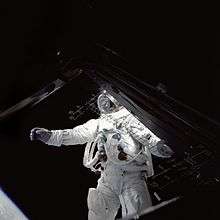
Rusty Schweickart stands on the porch of Spider during his extravehicular activity on the fourth day of the mission
-

Apollo 9 LM Spider
-
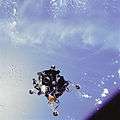
LM Spider over ocean
-
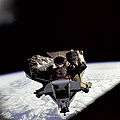
The LM Spider ascent stage on the fifth day of the mission
Spacecraft location
The Apollo 9 Command Module Gumdrop (1969-018A) is on display at the San Diego Air & Space Museum, San Diego, California. Its Service Module (SM) was jettisoned shortly after the deorbit burn and decayed during reentry of the Command Module.
The ascent stage of LM-3 Spider (1969-018C) decayed on October 23, 1981.[10]
The descent stage of LM-3 Spider (1969-018D) decayed March 22, 1969.[10]
The upper stage of the Apollo 9 Saturn V, S-IVB-504N, (1969-018B) remains in heliocentric (solar) orbit as of 2014.[8]
See also
References
![]() This article incorporates public domain material from websites or documents of the National Aeronautics and Space Administration.
This article incorporates public domain material from websites or documents of the National Aeronautics and Space Administration.
- ↑ Orloff, Richard W. (September 2004) [First published 2000]. "Table of Contents". Apollo by the Numbers: A Statistical Reference. NASA History Division, Office of Policy and Plans. NASA History Series. Washington, D.C.: NASA. ISBN 0-16-050631-X. LCCN 00061677. NASA SP-2000-4029. Retrieved June 27, 2013.
- ↑ McDowell, Jonathan. "SATCAT". Jonathan's Space Pages. Retrieved March 23, 2014.
- ↑ "Apollo 9 Crew". The Apollo Program. Washington, D.C.: National Air and Space Museum. Retrieved 10 May 2015.
- ↑ "'Open End' Orbit Planned for Apollo". The Pittsburgh Press. Pittsburgh, PA. United Press International. August 4, 1966. p. 20. Retrieved November 11, 2010.
- ↑ Brooks, Courtney G.; Grimwood, James M.; Swenson, Loyd S., Jr. (1979). "Preparations for the First Manned Apollo Mission". Chariots for Apollo: A History of Manned Lunar Spacecraft. NASA History Series. Foreword by Samuel C. Phillips. Washington, D.C.: Scientific and Technical Information Branch, NASA. ISBN 0-486-46756-2. OCLC 4664449. NASA SP-4205. Retrieved January 29, 2008.
- ↑ "Apollo Image Gallery: Early Apollo". Project Apollo Archive. Kipp Teague. Retrieved August 3, 2010.
- ↑ Brooks, Courtney G.; Grimwood, James M.; Swenson, Loyd S., Jr. (1979). "Apollo 5: The Lunar Module's Debut". Chariots for Apollo: A History of Manned Lunar Spacecraft. NASA History Series. Foreword by Samuel C. Phillips. Washington, D.C.: Scientific and Technical Information Branch, NASA. ISBN 0-486-46756-2. OCLC 4664449. NASA SP-4205. Retrieved January 29, 2008.
- 1 2 "Saturn S-IVB-504N - Satellite Information". Satellite database. Heavens-Above. Retrieved September 23, 2013.
- ↑ Hengeveld, Ed (May 20, 2008). "The man behind the Moon mission patches". collectSPACE. Retrieved July 18, 2009. "A version of this article was published concurrently in the British Interplanetary Society's Spaceflight magazine."
- 1 2 "Apollo 9". National Space Science Data Center. NASA. Retrieved April 7, 2014.
Bibliography
- Baker, David (1982). The History of Manned Space Flight (1st ed.). New York: Crown Publishers. ISBN 0-517-54377-X.
External links
| Wikimedia Commons has media related to Apollo 9. |
- "Apollo 9" at Encyclopedia Astronautica
- NSSDC Master Catalog at NASA
NASA reports
- Apollo 9 Press Kit (PDF), NASA, Release No. 69-29, February 23, 1969
- "Table 2-37. Apollo 9 Characteristics" from NASA Historical Data Book: Volume III: Programs and Projects 1969–1978 by Linda Neuman Ezell, NASA History Series, NASA SP-4012, (1988)
- "Appendix 6 - Crews and Support for Manned Apollo Flights". The Apollo Spacecraft: A Chronology. Volume IV. NASA. 1978. OCLC 23818. NASA SP-4009. Archived from the original on February 5, 2008. Retrieved January 29, 2008.
- "Apollo 9 flight plan AS-504/CSM-104/LM-3 Final Report" (PDF) by J. V. Rivers, NASA, February 1969
- The Apollo Spacecraft: A Chronology NASA, NASA SP-4009
- "Apollo Program Summary Report" (PDF), NASA, JSC-09423, April 1975
Multimedia
- Apollo 9: Three To Make Ready Official NASA documentary film (1969)
- Apollo 9 16mm onboard film part 1, part 2 raw footage taken from Apollo 9
- Apollo 9: The Space Duet of Spider & Gumdrop Official NASA documentary film (1969), OCLC 7682161
- Apollo 9 images at NASA'S Kennedy Space Center
- Apollo launch and mission videos at ApolloTV.net
